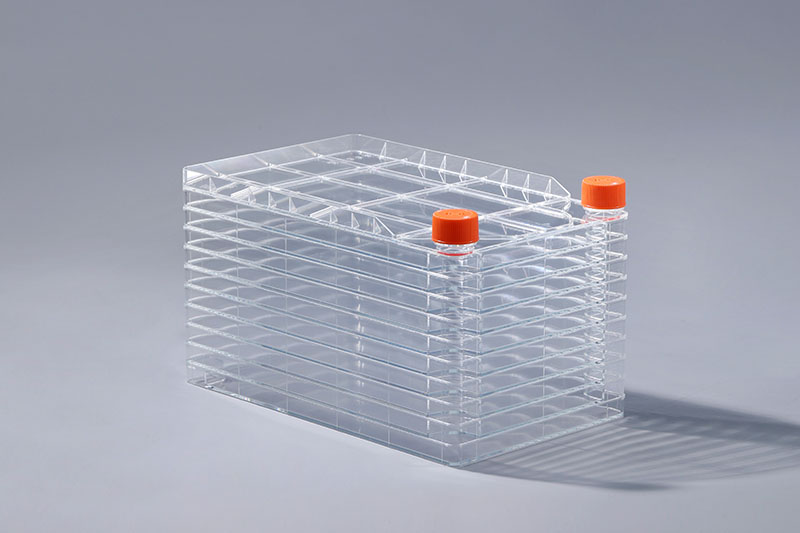Má tharlaíonn éilliú baictéarach sna cealla sa mhonarcha cealla, an fhoinse Ba cheart anailís a dhéanamh ar éilliú de réir an staid shonrach, agus ansin ba cheart an chóireáil a dhéanamh de réir an staid éillithe. Má tá an éilliú an-tromchúiseach, moltar an cultúr a chaitheamh amach agus é a athshaothrú.Is cineál earraí inchaite iad a úsáidtear go forleathan i gcultúr cille ar scála mór. Is orgánaigh an-leochaileach iad cealla. Tá timpeallacht ar leith ag teastáil ó chultúr in vitro na gceall, agus is é an steiriúlacht an bunriachtanas. próiseas an chultúir in vitro, tá cealla easpa cosanta an chomhlachta chóras imdhíonachta agus caillfidh an cumas a chosaint i gcoinne microorganisms agus díthocsainithe substaintí díobhálacha. Chun a chinntiú gur féidir le cealla fás agus atáirgeadh in vitro, is gá a chinntiú go bhfuil limistéar oibre steiriúil, sláinteachas pearsanta maith, imoibrithe steiriúla agus meáin, agus láimhseáil aiseiptigh. fungais. Níl aon tocsaineacht marfach ag mycoplasma, féadann sé a bheith in aontíos le cealla ar feadh i bhfad, agus tá éifeachtaí féideartha aige ar chealla, ach tá sé beag i méid agus deacair a aithint. Is féidir é a bhrath trí léicean dearg nó staining Hoechst33342. Iomadaíonn baictéir go tapa, is féidir leo a mhéadú i méid mór i mbeagán ama, agus tocsainí a tháirgeadh chun cealla a mharú. Tá go leor cineálacha fungais ann, atá le feiceáil ar an tsúil naked, ag snámh ar dhromchla an mheáin chultúir, agus is féidir iad a bheith filamentous, tiúbacha nó dendritic.
In vivo, the detoxification system and immune system can resist the invasion of microorganisms or other harmful substances, but in the process of in vitro culture, cells lack the protection of the body's immune system and lose the ability to defend against microorganisms and detoxify harmful substances. To ensure that cells can grow and reproduce in vitro, it is necessary to ensure a sterile work area, good personal hygiene, sterile reagents and media, and aseptic handling.
Common microbial contaminations in cell factory culture include mycoplasma, bacteria, and fungi. Mycoplasma has no lethal toxicity, can coexist with cells for a long time, and has potential effects on cells, but it is small in size and difficult to identify. It can be detected by means of lichen red or Hoechst33342 staining. Bacteria proliferate quickly, can multiply in a large amount in a short time, and produce toxins to kill cells. There are many kinds of fungi, which are visible to the naked eye, floating on the surface of the culture medium, and can be filamentous, tubular or dendritic.
If bacterial contamination occurs in the cells in the cell factory, the source of contamination should be analyzed according to the specific situation, and then the treatment should be carried out according to the contamination situation. If the contamination is very serious, it is recommended to discard the culture and re-cultivate it.
The FAI climbed 5.9 percent year-on-year in the first 11 months of 2018, quickening from the 5.7-percent growth in Jan-Oct, the National Bureau of Statistics (NBS) said Friday in an online statement.
The key indicator of investment, dubbed a major growth driver, hit the bottom in August and has since started to rebound steadily.
In the face of emerging economic challenges home and abroad, China has stepped up efforts to stabilize investment, in particular rolling out measures to motivate private investors and channel funds into infrastructure.
Friday's data showed private investment, accounting for more than 60 percent of the total FAI, expanded by a brisk 8.7 percent.
NBS spokesperson Mao Shengyong said funds into weak economic links registered rapid increases as investment in environmental protection and agriculture jumped 42 percent and 12.5 percent respectively, much faster than the average.
In breakdown, investment in high-tech and equipment manufacturing remained vigorous with 16.1-percent and 11.6-percent increases respectively in the first 11 months. Infrastructure investment gained 3.7 percent, staying flat. Investment in property development rose 9.7 percent, also unchanged.
 English
English



















































